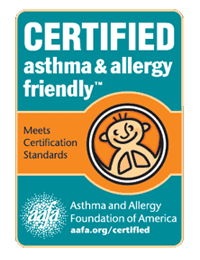As summer heats up, you may want to open your windows. But if you have a pollen allergy, you could be introducing pollen into your home. And thanks to climate change, we’re seeing not only higher temperatures, but longer pollen seasons as well. Pollen allergy is one of the most common triggers of seasonal allergic rhinitis, or “hay fever.”
Pollen can also trigger allergic asthma. If you have allergic asthma, managing your seasonal allergies can help you manage your asthma too.
To avoid bringing pollen inside, it is recommended that people with pollen allergies keep their windows closed during pollen season or at peak pollen times. But many people don’t have air conditioning to cool their homes and workplace when it’s hot. So, what can you do if you have a pollen allergy but want to open your windows to let air circulate?
Pollen Screens May Help Reduce Pollen Indoors
Reducing your exposure to allergens in your home or workplace is an important part of asthma and allergy management. To help prevent pollen from entering inside while staying cool, pollen screens can be installed in window frames. They may allow you to open your windows and ventilate your indoor spaces without letting pollen inside.
While there are window-mounted pollen screens available, more testing is needed to prove which ones will keep pollen out. In an important step to promote an accessible option for people with asthma and pollen allergies, the asthma & allergy friendly® Certification Program has created a new standard for window-mounted pollen screens.
The new standard ensures that any pollen-blocking window screens that earn the asthma & allergy friendly® certification mark must pass rigorous scientific testing standards to prove that they:
- Can effectively block the passage of pollen
- Can be cleaned of captured pollen for lasting performance
- Have a low presence of allergenic chemicals and volatile organic compound (VOC) emissions
The new window-mounted pollen screen certification standard involves a three-step testing process:
- First, the screens are tested for their ability to block the passage of pollen. Testing involves three types of pollen – tree pollen, grass pollen, and weed pollen – to capture the major groups of pollens. The screens must effectively block all three types of pollen to receive certification.
- Second, the removal of pollen from the screen by cleaning is tested. To ensure lasting performance of a pollen screen, it must be possible to remove captured pollen to maintain ventilation while retaining performance.
- Last, the chemical makeup of the product is assessed for the presence of allergenic chemicals and emissions of VOCs to make sure they are below certification levels.
A CERTIFIED window-mounted pollen screen would help reduce pollen in your indoor environment and support healthier indoor spaces.
In the future, we hope to certify pollen screens against this standard. Join our community to get updates when we add pollen screens and other products to our asthma & allergy friendly® Certification Program.

Visit aafa.org/certified to search for CERTIFIED products. There you can also learn more about the asthma & allergy friendly® Certification Program.

Comments (0)